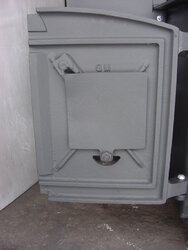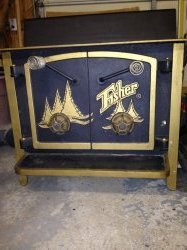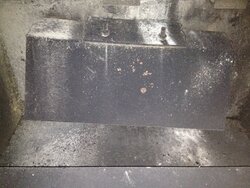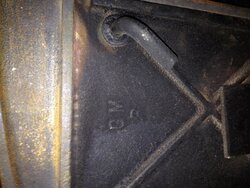Welcome to the forum, I'll give you your own thread;
The seller of that stove originally listed it as a Grandma and I messaged him to let him know the measurements were of a Grandpa, but it has Grandma doors. Could have been out of GP doors at the time and used what they had to get a Grandpa delivered.
It was sold and the first buyer backed out, then relisted.
No gasket material was used originally on the door seal, that was added by owner as well as the paint colors. The picture of inside of door is cut off. The plate inside looks like it may be a "nickel shield" that would be used on plated doors. Below is a picture of those shields. If that is what yours has inside, they are plated doors. Don't know why they were painted unless rusted with ruined plating. The angle iron corners and 1 inch channel iron trim on ash fender was black to match the stove.

Nickel heat shield optional for plated doors.
The only factory baffle in later Grandpas would be a plate 27 X 3 1/2.
There was no bolts used inside the stove, and no round baffle or plates. (other than the 1/2" X 4" bolt for draft cap)
It's a Grandpa box with wider front plates than normal to fill the gap from door opening to edge at corner using smaller doors. (strips at sides of door fabricating stove front)
It would use a Grandma rectangular screen (chrome called Contemporary) with latches or the newer Cathedral arched top screen that sits on the door hinge ears, part # 237-585-1
The earliest it could be is 1979. That was the first year the Cathedral doors were offered as an option with the old style box like you have.
1980 started bent corners without the angle iron down corners with only Cathedral doors. That doesn't mean it's not newer. The old style box was made by many shops as a cheaper alternative to the newer box with bent corners designated with the III. They also had shields bottom and rear with UL tag attached to rear shield. I believe yours is a FS II with or without shields. Shields were not added if someone was installing on a non combustible hearth with no clearance issues.
Look for any weld marks on the bottom. (writing) NJ and NY stamped the back upper corners. The numbers usually have the state abbreviation as well. Door marking won't tell you where the stove was made.
If you replace rivets, the Cathedral doors use at least 1 3/4 long, not the shorter 1 1/4. I've posted a few times how to make your own from a 3/8 bolt if you have a bench grinder and drill to chuck the bolt in to form the head. They are quite easy to make. (If the hole isn't worn too large) Keeping the pins and bolt threads for draft caps greased with high temp grease or silver anti-seize prevents wear and the need to replace.


 New member. First post. Hope I do this correctly.
New member. First post. Hope I do this correctly.

